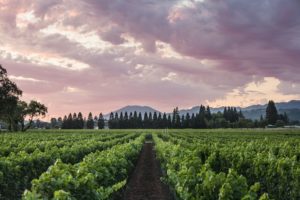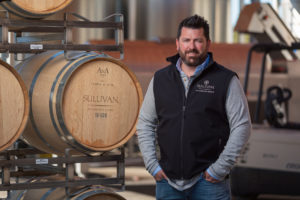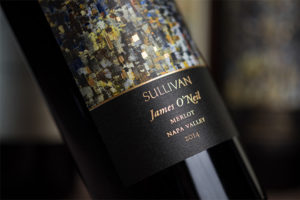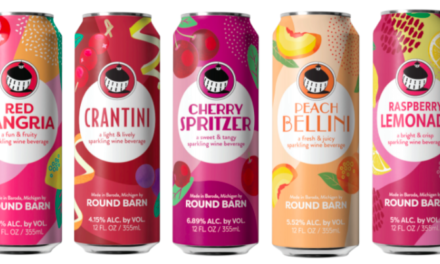With so much cabernet sauvignon being produced in Napa Valley, making one that stands out has become a considerable challenge.
Popular production methods guaranteed to deliver big, bodacious wines include picking at high sugars, extended maceration, and de-alcing the wines to get down from near 16 percent ABV to something in the 14.5 territory. Adding tannins at fermentation is also popular, as is adding finishing tannins when finalizing a blend. These production tricks all tend to build dense wines with tremendous, weighty mouthfeel and tannins you can stick a fork in.
Then there are those who advocate for a more hands-off approach to help achieve the rich mouthfeel that is so prized. One of those is called “hard bung,” slang for letting the wine do its thing, post secondary fermentation, uninterrupted in a single barrel, for a good many months until you’re ready to think about blending. Basically, the wine is left alone with its thoughts, in solitary confinement, for multiple six-month intervals.
I asked Sullivan Rutherford Estate winemaker Jeff Cole, whom I’d met on a Zoom call somewhere in the middle of 2019, to share his insights into this more finessed method.

About Sullivan Rutherford Estate
Sullivan Rutherford Estate was founded in 1972 by James (“Jim”) O’Neil Sullivan, a visionary and pioneer. The 26-acre vineyard was originally planted in 1978 with encouragement from Rutherford’s most legendary winemaker, André Tchelistcheff. Streaks of well-drained gravel produce fewer clusters and smaller berries, resulting in generous and complex cabernet sauvignons and mighty impressive merlots.
In 2018, Mexican entrepreneur Juan Pablo Torres-Padilla fell in love with the Sullivan estate after spending several years visiting more than 120 Napa Valley wineries in search of the perfect property. A native of Mexico City, he earned a master’s degree in engineering and economics at France’s École Polytechnique. He pursued a career in telecom after completing a master’s degree from MIT in Cambridge, Mass., but wine was his true calling. His love of wine, sparked by his maternal grandfather, led to him spend 15 years visiting and working at chateaus in Burgundy, Champagne, and Bordeaux.
At Sullivan, Torres-Padilla assembled a world-class winery team dedicated to elevating the estate’s foundation to create the next “first growth” wine from the Napa Valley. He hired elite vineyard manager Mike Wolf and rising star viticulturalist Caleb Mosley to implement new vineyard programs. Plans are underway to build state-of-the-art winery and hospitality facilities.
 Cole, who joined Sullivan Estate in 2013, is a Yountville native, surrounded by wine growing up. While pursuing a wine and viticulture degree from California Polytechnic University, he gained valuable experience at Laetitia Winery in Atascadero and Windward Vineyards in Paso Robles (both in California). His winemaking journey then took him to Schramsberg Vineyards in Napa Valley, where he learned the méthode champenoise of making sparkling wines. As of 2018, Cole, along with vineyard manager Caleb Mosley (who graduated Cal Poly one year after Cole), are upping their game of making world-class cabernet sauvignon from the estate property.
Cole, who joined Sullivan Estate in 2013, is a Yountville native, surrounded by wine growing up. While pursuing a wine and viticulture degree from California Polytechnic University, he gained valuable experience at Laetitia Winery in Atascadero and Windward Vineyards in Paso Robles (both in California). His winemaking journey then took him to Schramsberg Vineyards in Napa Valley, where he learned the méthode champenoise of making sparkling wines. As of 2018, Cole, along with vineyard manager Caleb Mosley (who graduated Cal Poly one year after Cole), are upping their game of making world-class cabernet sauvignon from the estate property.
I was curious about Cole’s secrets for making wines with such intense mouthfeel but that also exhibit a very smooth tannin profile. I posed a few questions.
SPIRITED: Can you explain the “hard bung” process once you bring grapes into the winery?
Jeff Cole (JC): Once the wine is through secondary [malolactic] fermentation and is stable, it’s racked off from the fermentation lees to better stabilize and prevent any microbial infection. The wine then goes back into its barrel, completely topped and preserved with a small amount of sulfur dioxide. Instead of using a tradition bung that can be removed at any time, I use a wooden bung that’s hammered in to create a hermetically tight seal. The barrels are then rotated so that the wine inside the barrel comes into contact with the wooden bung allowing it to swell to ensure the seal. Once sealed, the barrel lays fallow for six months before opening and evaluating. This process happens three times for a total of 18 months

What do you believe is going on with hard bung, from a physiological standpoint? How do you believe it helps to enhance the wines you’re making?
JC: Due to the humidity and temperature of a wine cellar, there’s the evaporative loss of water and alcohol through the barrel. As these liquids evaporate, it causes the wine to concentrate the phenolics, which is essentially the makeup of the wine—color, tannin, structure. This concentration causes the wine to become richer and more full-bodied, giving a greater sense of luxury and overall complexity.
Does this method add or reduce the amount of work you have to do in processing the wine?
JC: It adds a little more work when installing and removing the bung but reduces overall work on a monthly basis, because I don’t have to top and sulfur regularly.
You’ve mentioned that you inherited very large tanks (6,000 gallons each) for the big lots the winery used to process, but that you needed smaller tanks to accommodate the way you pick fruit. What did you end up installing?
JC: I’ve moved on from the larger tanks and am now using smaller tanks, which helps greatly with controlling fermentation letting me make more consistently great wine. The plan is to build a new winery on top of the cellar and implement gravity feed protocols, which, with the hard bung process, will further improve the quality of the wine.
Once the winery is built in the next couple of years, I’ll move to even smaller tanks (approximately 1,000 gallons each), which will again help me to create wines that really showcase and express the terroir of Sullivan Rutherford Estate.
You first started using the hard bung process in 2016. What prompted you to explore this methodology? What improvements were you trying to achieve in the resulting wines?
JC: For years prior, I’d been trying to think of a way to naturally concentrate and make more delicious wine. I’d brought [hard bung] up to other winemakers I worked with in the past, but no one really wanted to implement it. Once I had complete control of the winemaking decisions it was a no brainer for me to at least try. I started off small and really attempted to perfect the process so I could replicate it on a larger scale while maintaining the integrity of the wine.
You switched to hard bung on all lots in 2018. Does that mean all lots of just the cabernet, or the merlot as well?
JC: It worked so well with the cabernet sauvignon lots that I thought, ‘Why not on all lots?’ So in 2018, all wine I made went through this protocol. I’ve even used it on a small amount of estate chardonnay—with great success.
Have you altered your barrel selections since employing hard bung?
JC: I haven’t altered my barrel selection specifically for the hard bung process, but I have altered it to better complement our site-specific wines.
How did the fires of 2020 impact your winemaking efforts at Sullivan?
JC: It was a challenge. Due to my experience working with prior fires, I felt there was still an opportunity to make wine that would deliver on the quality that’s expected from a Sullivan bottle, only in smaller quantities.
Some of our earlier picks are showing no signs of being affected by smoke and are pristine. The hard bung technique concentrates all the phenolics in the wine so that aging strategy will be used with our very best lots. Some of our other lots will likely not be made with the hard bung method.

You mentioned another tier of wine above the James O’Neil level. What would that look like? Would this be solely merlot?
JC: Since Sullivan Rutherford Estate has been under new ownership, we’ve been working to develop a wine that will be considered one of the best in the world. While I can’t speak to what the wine will be comprised of, I can say there will be a heavy percentage of merlot.
Have you replanted any of the estate cabernet vines to merlot?
JC: We’re currently undergoing an eight-and-a-half-acre replant on our Rutherford Estate, and half of that replant is merlot. I believe that, if merlot gets the full attention from our vineyard management, from the winemaking team, and being grown on the best soils in the Napa Valley, it can produce wines that rival the best cabernet sauvignon.
We at Sullivan Rutherford Estate are so excited to kick off the next chapter from this historical site. We feel we produce a phenomenal merlot, a category that most people in Napa Valley don’t take seriously. I believe there’s a niche for it. We feel we can make merlot one of our signature wines.











